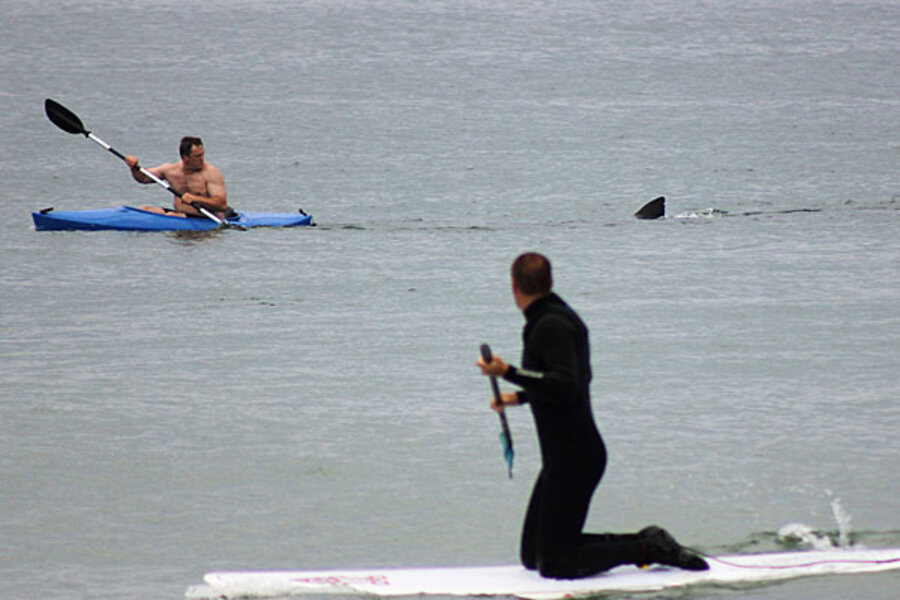Great white sharks: Close encounters on East and West coasts
Loading...
| ORLEANS, Mass. and PLEASURE POINT, Calif.
A Massachusetts man had a close encounter with a great white shark off the coast of Cape Cod.
Nauset Beach in Orleans reopened Sunday after being closed briefly Saturday when a shark was seen swimming not far from shore.
Orleans resident Dana Richardson tells the Cape Cod Times he saw a shark fin following him Saturday while he was paddle boarding about 200 feet from shore in eight feet of water, and then later spotted a fin following a kayaker. The kayaker quickly rowed ashore.
IN PICTURES: Top shark attack locations
Experts say the sharks are being drawn to Cape Cod's waters by an abundance of seals, a favorite meal of the predatory fish. Swimmers in Chatham have been told to steer clear of seals after sharks were seen in the water there last week.
Meanwhile, in California waters, a great white shark, estimated to be up to 18 feet long, sheared through the front end of a kayak floating about a quarter-mile from the popular Eastside surf spot known as Pleasure Point in Monterey Bay near Santa Cruz, Calif,, authorities said.
The attack, which happened about 8:30 a.m. Saturday, is a rare occurrence for the area, as no one has reported a shark bite in several decades in the waters around Santa Cruz County, according to Sean Van Sommeran of the Pelagic Shark Research Foundation.
On Saturday, a 52-year-old Fremont, Calif., man was fishing from his 13.5-foot kayak when he felt the shark bump up against the back of the boat.
Within seconds, the shark lifted up the kayak and attacked the front, sheriff's deputies said.
The man, thrown from the kayak, was unharmed.
He was plucked from the ocean by a boater nearby who had witnessed the incident.
The man was fishing with two friends in about 40 feet of water just outside a kelp bed when the attack occurred.
The man's friends, in separate kayaks, were not injured.
The shark's teeth sliced through the thick shell of the yellow kayak, and investigators extracted tooth fragments from the bite marks.
Van Sommeran was called to inspect the bite, and he immediately confirmed it was the work of a great white — the world's largest predatory shark.
"Those teeth can go right through bones and saw apart seals," Van Sommeran said. "They're designed to dismantle sea animals. They rarely bite humans."
While shark attacks in the Monterey Bay are rare, shark sightings are common.
It's not unusual to hear of sharks being spotted near Seacliff and La Selva beaches, Van Sommeran said.
A great white was reportedly seen near Marina two weeks ago, he said.
The only shark bite Van Sommeran could recall in Santa Cruz County was in 1960, when a woman was badly bitten near Sand Dollar Beach between La Selva and Watsonville.
Sharks are known to cruise the California coast between October and January, feeding off seals and other sea life before heading farther out to sea for the winter.
Capitola, Calif., police issued a text message alert on Saturday to warn surfers and beachgoers about the attack and advise caution when playing near the ocean.
"Enter at your own risk," the message read.
Surfers and beachgoers appeared undaunted by news of the attack.
The head-high waves churning on Saturday brought large numbers out to enjoy the swell, including Fredrik Thorsteidsson, who heard about the shark bite while standing in line for coffee at Verve in Capitola.
"So many people have surfed here for so many years and never been bit," said the 37-year-old while contemplating surfing The Hook. "The probability is so low. It's more dangerous to fly a plane or drive a car. It doesn't worry me."
IN PICTURES: Top shark attack locations
———
©2012 Santa Cruz Sentinel (Scotts Valley, Calif.)
Visit the Santa Cruz Sentinel (Scotts Valley, Calif.) at www.santacruzsentinel.com
Distributed by McClatchy News Service MCT Information Services





